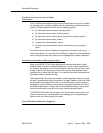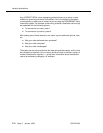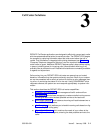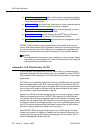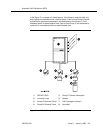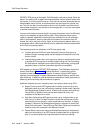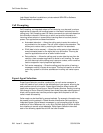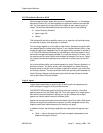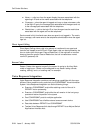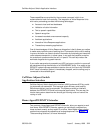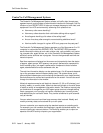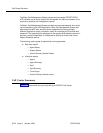
Look-Ahead Interflow
Issue 5 January 1998
3-7555-230-024
Off-loading of Periodic Excess Calls
A vector can check conditions in the targeted hunt group, such as the number of
calls already in queue. If the number is above a certain threshold, the vector
bypasses that hunt group and routes the call to another hunt group or the vector
can return a busy signal. However, if the number is below the threshold, the vec-
tor queues the call to that hunt group.
Information Announcements
for the Calling Party
The human intervention needed to distribute common messages can be mini-
mized with information announcements. People with a common interest can be
instructed to call a specific number (a Vector Directory Number) that connects to
a specific announcement vector, which routes callers to a voice messaging sys-
tem or to an integrated announcement circuit pack in the system.
Look-Ahead Interflow
Look-Ahead Interflow allows two DEFINITY systems equipped with Automatic
Call Distribution, Call Vectoring, and interconnected Integrated Services Digital
Network-Primary Rate Interface (ISDN-PRI) lines to exchange information on the
D-channel. In this way the systems can predetermine whether the receiving sys-
tem can handle a call diverted from the sending system. This feature allows your
company to ensure serving your customers incoming calls within specified ser-
vice levels, even when one of your call centers is experiencing increased call
requests. For example, you could direct calls to your call center in London if your
call center in Paris is experiencing heavy call requests or cannot satisfy incoming
calls for some reason.
Look-Ahead Interflow enhances Call Vectoring interflow by ensuring that calls do
not interflow to a backup system that cannot satisfy expected service levels.
A Look-Ahead Interflow call is attempted when a route to number command suc-
cessfully accesses an ISDN-PRI trunk group. A vector on the receiving system
then either accepts or denies the Look-Ahead Interflow call attempt based on
some condition, usually an Expected Wait Time threshold. The sending system
does not relinquish control of the call until it is accepted by the receiving system.
Until the call is accepted, the caller continues to hear any audio (such as ring-
back or music) applied by the sending system, and the call remains in any send-
ing system queues. If the call is accepted, the call is removed from any queues
at the sending system, and control of the call is passed to the receiving system.
If the call is denied, vector processing simply continues at the sending system.
Audible feedback and the call’s position in any queues at the sending system
remain unaltered so the caller is unaware that a Look-Ahead Interflow call
attempt has been made. The call vector may then apply alternate treatment,
which may include placing another Look-Ahead Interflow call to an alternate
backup system.



